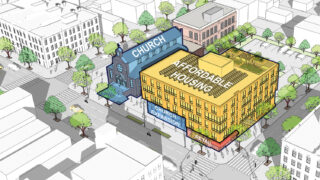
My tenure as president of the AIA New York Chapter this year has been a remarkable journey of collaboration, inspiration, and foundation-setting. With a goal of sparking dialogue and rethinking default models of practice, my presidential theme centered the concepts of belonging and community engagement.
Well-being, quality of life, and flourishing are directly tied to belonging—patterned experiences of being recognized and personally connected to physical spaces. This is another reminder that no practitioner is a neutral actor, and design is never neutral, either. Community voices and perspectives bring important considerations, priorities, and possibilities to the forefront when participation on-ramps are intentional, valued, and facilitated throughout the design process.
My own lived experiences are often difficult to articulate, though my start in life mirrored the context of millions of Black Americans born in the North to hopeful, young parents who left home to find better economic opportunities and escape the violence, oppression, and indignities of Jim Crow. My family settled in the South Bronx, New York City’s poorest area at that time, drawn by its affordability. My earliest years unfolded in a third-floor apartment facing an elevated train line that rumbled past the window every 15 minutes, day and night. The elevator rarely functioned, and a persistent foul odor permeated the hallways. Our apartment was spacious but had been long unmaintained, and we suffered from infestations beyond imagination. We had no better solutions, though; rent was just $25 a month, and these conditions were commonplace throughout the community.
These were hard times—the journey made bearable by the extraordinary care, compassion, and sense of community that surrounded us. Every race and ethnic background seemed to be present in our neighborhood, and attitudes and mindsets of pride and solidarity were nurtured. Adults watched each other’s children, assisted those in need, and transformed portions of nearby Crotona Park into safe play areas. We youth painted benches, repaired swings, and adorned abandoned buildings and rock outcroppings in the park with graffiti art featuring positive messages. On scorching summer days, we opened fire hydrants and splashed with all the other kids in the streets, while box fans in our kitchen windows worked tirelessly. We did what we could with what was available to us, and our experiences were almost always collective. My subsequent years in Colonial Park Houses, a public housing project in Harlem, were extremely similar. I have no doubt these experiences of displacement, poverty, inclusion, and intergenerational community-mindedness continue to inform my excitement about this year’s theme.
The practices of unpacking our own lived experiences and assumptions, and listening to and learning from others’ lived experiences and priorities, can and should profoundly impact the ways we frame and pursue every design project. As I stated in my inaugural speech:
“At the heart of our work as architects lies an unwavering faith in the transformative power of design. The voices and wisdom of our communities must never be sidelined in the processes that shape the environments they envision and inhabit. Architects possess not only the ability to mold the physical landscapes where people dwell, work, and recreate, but also the power to advocate for how we perceive ourselves and one another within the intricate tapestry of society.”
Please stay curious, informed, and engaged as AIANY prepares to support practitioner learning, mindset, and practice shifts, and advocate for community engagement reform and opportunities for innovation over the next few years. And think about your own and others’ lived experiences, and the types of expertise therein, in the meantime.























